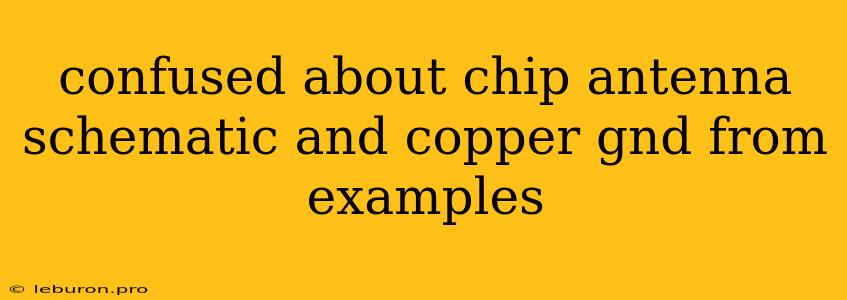Understanding Chip Antenna Schematics: A Guide to Copper Ground and Its Role
Navigating the intricate world of chip antenna schematics can be daunting, especially when confronted with the seemingly arbitrary placement of copper ground planes and their connection to the antenna itself. Many designers, both seasoned and novice, find themselves confused about chip antenna schematics and the role of copper ground. This confusion often stems from the lack of clear understanding of the underlying principles and how they manifest in the physical layout of the antenna. This article aims to demystify this process, providing a clear explanation of chip antenna schematics, the significance of copper ground planes, and the interplay between them.
The Chip Antenna: A Compact Solution
Chip antennas are increasingly prevalent in modern electronic devices, offering a compact and cost-effective solution for wireless communication. They are typically fabricated on a printed circuit board (PCB), integrating the antenna elements with other circuit components. The small size and intricate design of chip antennas, however, present unique challenges, particularly when it comes to achieving optimal performance.
Understanding the Schematic: Key Components
A typical chip antenna schematic comprises several key components, each with its own role in ensuring efficient signal transmission and reception.
1. The Antenna Element:
This is the primary component responsible for radiating or receiving electromagnetic waves. It is usually a small, printed structure, often a meander line or a patch, that interacts with the electromagnetic field.
2. The Matching Network:
This network, often a combination of capacitors, inductors, or transmission lines, is crucial for matching the antenna impedance to the impedance of the connected circuitry. This matching process ensures maximum power transfer, optimizing the antenna's performance.
3. The Ground Plane:
This conductive surface, usually made of copper, serves as a reference plane for the antenna. The ground plane plays a crucial role in defining the electrical field distribution around the antenna, which in turn influences signal radiation and reception patterns.
The Role of Copper Ground in Chip Antenna Design
The copper ground plane is often overlooked in chip antenna design, but it plays a crucial role in determining the antenna's overall performance. It is not simply a passive element, but an integral part of the antenna structure, contributing to:
1. Impedance Matching:
The ground plane acts as a reference plane for the antenna, influencing its impedance characteristics. Proper ground plane design is crucial for achieving optimal impedance matching, which maximizes the power transfer between the antenna and the connected circuitry.
2. Radiation Pattern Control:
The shape and size of the copper ground plane directly affect the antenna's radiation pattern. By strategically shaping the ground plane, designers can control the direction and intensity of the radiated signal.
3. Signal Filtering:
The copper ground plane can help suppress unwanted frequencies or noise, improving the overall signal quality and reliability.
Decoding the Schematic: Copper Ground in Action
Many designers struggle to understand chip antenna schematics where the copper ground is depicted as a continuous, solid plane, sometimes even connecting directly to the antenna element. This can lead to confusion, especially when comparing different schematic representations. Here's a breakdown of common scenarios:
1. Direct Connection to the Antenna Element:
In some cases, the copper ground is directly connected to the antenna element, especially in compact designs. This connection is not a random act but reflects the need to create a specific impedance match or a particular radiation pattern. The direct connection might be a deliberate design choice, not a result of oversight.
2. Isolated Ground Planes:
Sometimes, the copper ground plane might appear as multiple isolated sections, disconnected from the antenna element. This arrangement might be used to control the radiation pattern by creating distinct regions with different electrical properties.
3. Ground Planes with Gaps and Slots:
In some designs, the copper ground plane may feature gaps or slots strategically placed to achieve a specific impedance match or to manipulate the radiation pattern. These intentional interruptions can be complex but are critical for optimizing antenna performance.
The Importance of Practical Testing and Simulation
While understanding the schematic is crucial, it is only the first step in the design process. Practical testing and simulation are essential for verifying the antenna's performance and identifying any unexpected issues. Simulations can be used to visualize the electromagnetic fields around the antenna, allowing designers to fine-tune the copper ground design for optimal performance.
Conclusion: Demystifying the Chip Antenna
Understanding chip antenna schematics and the role of copper ground planes is vital for successful antenna design. It is not a simple matter of following arbitrary rules but a sophisticated process of engineering a precise electromagnetic environment. By embracing the principles outlined in this article, designers can navigate the seemingly confused about chip antenna schematics, effectively incorporate copper ground, and achieve optimal performance in their compact wireless solutions.
